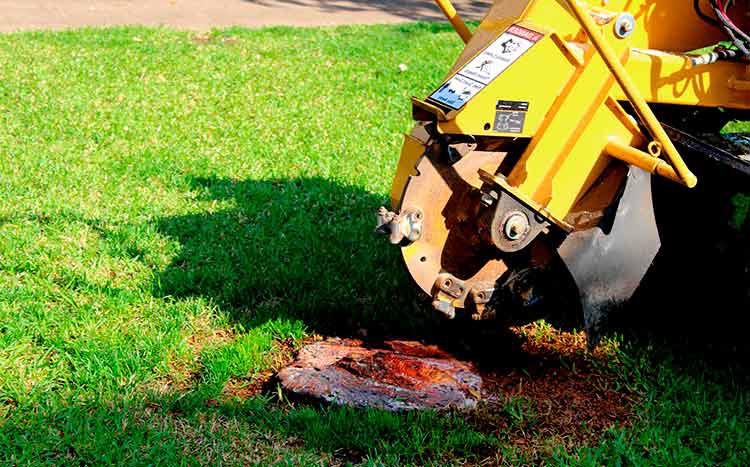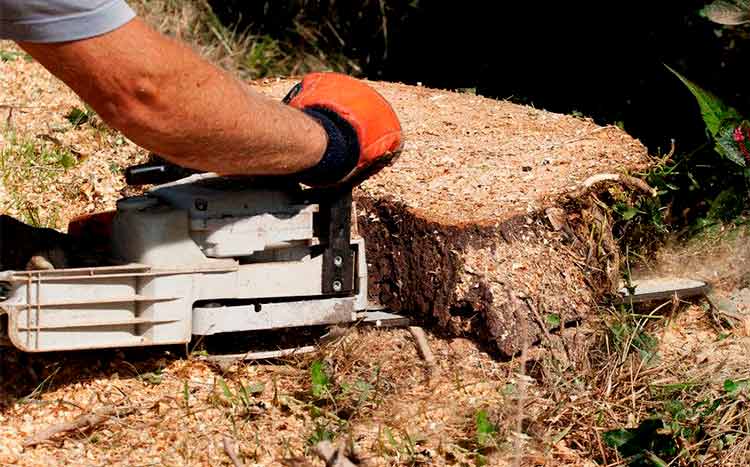Other than being ugly, leaving stumps in the ground decrease curb appeal and actually lower your property value, and expose you to unnecessary legal liability.
If you don’t grind a tree stump, it will attract pests, and develop new shoots and in cases where the parent tree was diseased, failing to grind it can encourage the disease to spread to neighboring trees.
Here is what you should know about stump grinding and why it is necessary.
If you have tree stumps on your property, you should remove them as soon as possible. The following are the main reasons why this is absolutely necessary.
New shoots will start to develop
Some tree species can survive even after cutting their trunks. Therefore, as long as tree roots are intact, they can develop new shoots.
With time, these shoots can grow into new trees. And then you will have to cut these trees too.
Your property will become a pest magnet
Carpenter ants and termites love stumps. They use them as a convenient source of shelter. Some types of ants even use them as a food source. Therefore, failing to remove a stump from your property will increase the odds of ending up with an infestation.
The value of your property will drop
A home that is littered with stumps isn’t attractive. It is even worse when the stumps rot or when they develop fungal growths.
Buyers tend to look at the aesthetic appeal of a home when determining how much they are willing to pay. As a result, attractive homes tend to command higher prices in the market. And since stumps will make your home less attractive, leaving them on your property is likely to reduce its value.
There will be an increase in accidental tripping and injuries
Low tree trunks pose a tripping danger. As a result, any children who are playing in the yard will be at an increased risk of tripping and injuring themselves on the stump.
Any visitors who are unaware of the stumps can also injure themselves. This is especially so if the stumps are low cut or if they are covered by grass or weeds.
You will expose yourself to unnecessary legal liability
As a homeowner, you can be held legally liable for any accidents that happen on your property. Therefore, if a neighbor comes to your home and trips and injures themselves on a tree stump, you can be held liable for any losses that occur as a result of the injuries or tripping.
Why do you need to stump grind?
Stump grinding is an easy way of solving a lot of stump-related problems. Here are some of the reasons why it is something that you should be thinking about doing.

To free up valuable space on your property
Tree stumps take up space. They also limit what you can do with your space because they act as obstructions.
With stumps randomly sticking out of the ground, you can’t move as freely on your property. And you also won’t have the freedom to set up structures or gardening spots as you always have to account for the presence of the stump.
Therefore, grinding works as an effective way of freeing up space in a home.
To prevent pest infestations
Insects, like termites and carpenter ants, will be attracted to a tree stump on your property. They use it as shelter. And some even feed on the dead stump. Therefore, leaving a tree stump in place will act as a pest magnet.
To avoid the nuisance of having to deal with pests, you should just grind the tree stump.
To improve the aesthetic appeal of your property
Stumps make a property look unkempt. This is especially so if they are rotten or if they have developed fungal growths. They can even lower a given home’s property value.
Grinding tree stumps reduces their visibility. It also makes them less of an eyesore. And it is sometimes enough to restore a property’s value and attractiveness.
To make your home safer
A stump in your yard is a tripping hazard.
When playing, children can trip over tree stumps. The resulting injuries can be very serious. The same can happen to unsuspecting neighbors and visitors. As such, grinding any stumps in your property will eliminate this safety hazard. It will go a long way towards making your property safer.
To stop the spread of tree diseases
If tree removal was occasioned by a tree disease, leaving the tree stump in place can still spread the disease to healthy trees on your property. Grinding it can thus be a way of minimizing the risks of spreading the infection to other plants.
To make gardening and property maintenance easier
Tree stumps can damage mowers and other gardening equipment. They can restrict the movement of machines that you regularly use to maintain your property. Therefore, you can grind tree stumps on your property to make it easier to garden and maintain your property.
What to do after grinding a stump?
Here is what you should do after grinding a tree stump.
Collect the wood chips and use them as mulch
Wood chips are a byproduct of stump grinding. And while you can dispose of them, there is always the option of using them to enrich your garden. This is because they make excellent mulching material.
The only time that using the wood chips as mulch is not an option is when the tree was diseased. Since the wood chips can still spread the disease, it is always advisable that you either burn the wood chips or dispose of them.
Plant grass in the area
After getting rid of the wood chips, you should add topsoil to the area. You should then add enough fertilizer to the soil, plant grass, and then water it. This should be enough to restore the aesthetic appeal of the area.
Plant another tree
Instead of grass, you can opt for planting a new tree near the stump area.
Before planting a new tree, you will have to remove the wood chips, fill the area with fertile soil and then water it. You can then plant the new tree at least 3 feet away from where the original stump was located.
To improve the odds of a successful new tree growth, it is always advisable that you plant a tree that is of a different species from the one that was removed.
Is it better to grind tree stumps or remove them?

It is better to grind a stump than remove it. Here are the reasons why.
It is faster
Stump grinding is one of the fastest ways of getting rid of a tree stump.
When you grind a stump, you are not interested in completely removing its anchoring system. You simply focus on eliminating the part that is sticking out of the ground.
This, in addition to the fact that stump grinders typically work really fast, usually helps to save time. As a result, it is an ideal option if you are looking for a fast solution to a stump problem.
It saves money
It is cheaper than to remove tree stumps.
Generally, its costs range from a low of $75 to a high of $400; while stump removal costs range from $370 to $675 per stump.
While the actual costs of either method vary depending on the age of the tree, where it is located, its diameter, and how easy it is to access; stump grinding is generally more affordable than stump removal simply because it is less demanding.
With grinding, you are not concerned about the tree root system. As a result, the tools that you need and the energy expended tends to be way less when compared to what is needed to remove a tree stump and its roots.
It has a relatively minimal impact on the environment
When compared to stump grinding, stump removal is highly intrusive. This is because it is a process that is concerned with more than the stump.
With tree stump removal, you get to remove both the stump and any tree roots attached to it. As a result, it is more likely to leave your landscape looking uglier, and remedying this effect will typically require spending more money and time.
Instead of subjecting your landscape to the trauma of tree stump removal, you can choose to simply grind it. This will have less of a negative impact on the environment.
The clean-up tasks after stump removal will also be less tedious. A tree service will also generally charge less for them than when compared to what they charge those that are usually associated with tree stump removal.
FAQ's
Most trees cannot grow back after stump grinding. This is because a tree service can grind an old tree stump up to 12 inches below the ground surface. In most cases, the stump grinder usually chews through the entire stump. This is usually too much damage for most tree species to recover.
However, there are trees that have an exceptional ability to regenerate. When you give them enough time — about 5 years — they can grow back. Trees like poplars, willows, and some types of flowering cherries, belong in this category.
Yes, it is bad to do so.
Leaving them in place will make your home unsafe by increasing accidental tripping and falls. It will also attract insects and pests to your property. And there is also the fact that stumps will definitely limit what you can do on your land.
However, while most tree service professionals will definitely advise you to remove a tree stump of a dead tree, you don’t have to do it if you have a way of repurposing the tree stump. You can make a picnic table out of it. And you can also use any of these 9 creative ideas to make the most of the stump.
If you need help removing stumps from your property, a professional tree removal service can come in handy.
GoTreeQuotes.com simplifies the process of finding a great tree service in your vicinity. It offers a free service that quickly matches you with the top-voted local tree experts in your area.
Using the website, you can get 3 estimates fast by real certified experts in your area in just 2 minutes. Here is how it works.
- You scroll to the top of the page and enter your Zip code.
- Answer questions about your stump removal needs
- Your details will be forwarded to three local experts.
- You will then receive a price estimate for the job and some friendly advice.
IMPORTANT: There is no obligation to hire. This is a free tool and service to be used at your pleasure.











